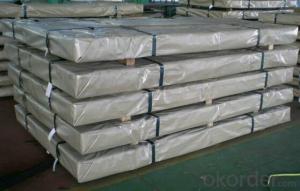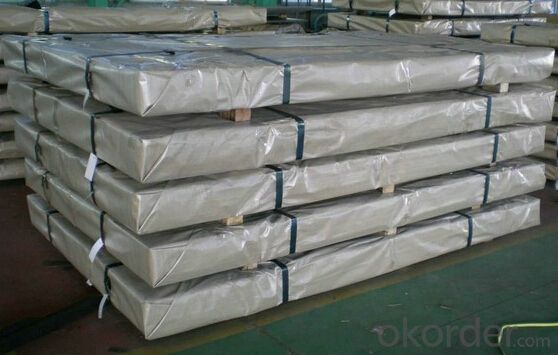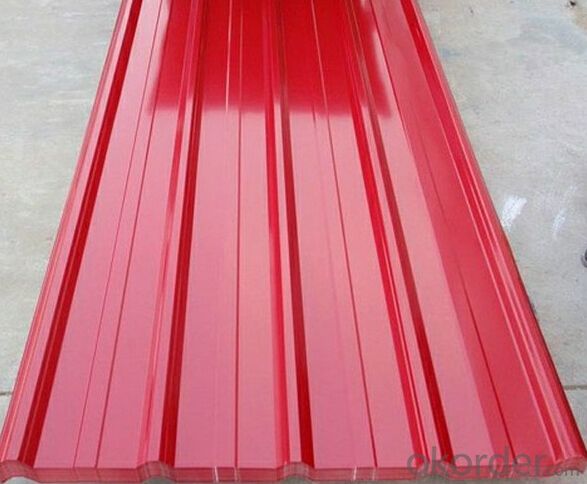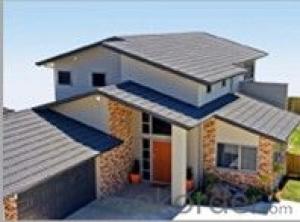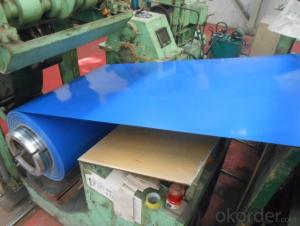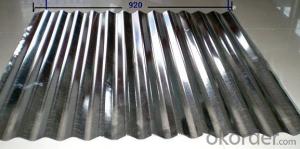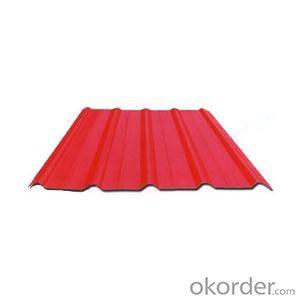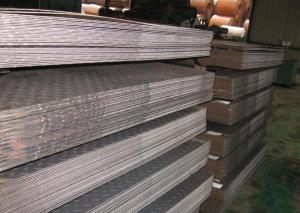Full Hard prepainted galvanized corrugated steel sheets
- Loading Port:
- Tianjin
- Payment Terms:
- TT OR LC
- Min Order Qty:
- -
- Supply Capability:
- 5000 m.t./month
OKorder Service Pledge
OKorder Financial Service
You Might Also Like
Product | Full Hard prepainted galvanized corrugated steel sheets |
Model No. | antique roof tile |
Material | ASTM A653, JIS G3302 SGCC/SGCH,GB/T2518, European standard |
Prepainted galvanized steel sheet | |
Technical | Zinc coated, color coated |
Thickness | Generally 0.3mm-0.6mm |
Effective width |
Generally 750mm/ 820mm/ 840mm/ 850mm/ 900mm/ 910mm/ 1050mm/ 1250mm
|
Length | Any length, according to the transportation, usually less than 12m |
Color | Standard color: blue, white, red |
Special color: according to RAL colors | |
Characteristics | 1.weather proof 2.Anti rust 3.Fire proof 4.Heating insulation 5.Long life span: more than 20 years |
Packing | Plastic film + steel pallet or as your request |
Application | Building material Container material Others, like machine structure parts, manufacturing shells of motors |
Delivery time | 15 days |
Payment term | T/T ; L/C |
- Q: How do you cut a steel sheet?
- In order to cut a steel sheet, it is necessary to utilize the correct tools and techniques. The following are several commonly employed methods: 1. Power tools: An angle grinder equipped with a cutting disc is the most frequently used power tool for cutting steel sheets. While operating the grinder, it is essential to wear safety goggles and gloves. Begin by marking the cutting line on the sheet using a marker or chalk. Then, slowly and steadily maneuver the grinder along the marked line to cut through the steel. 2. Shears: For thin steel sheets, manual or electric shears can be employed. These tools possess a scissor-like cutting mechanism specifically designed for cutting metal. Position the steel sheet between the shears' blades, aligning the cutting line with them, and apply consistent pressure to cut through the sheet. 3. Plasma cutting: This technique is most suitable for thicker steel sheets. Plasma cutting involves the utilization of a high-velocity jet of ionized gas (plasma) to melt and sever the metal. Specialized equipment, such as a plasma cutter utilizing an electric arc to generate the plasma jet, is necessary for this method. 4. Waterjet cutting: Another effective method for cutting steel sheets is waterjet cutting. This method employs a high-pressure jet of water mixed with an abrasive substance, such as garnet, to cut through the metal. Although this technique is ideal for intricate shapes and precise cuts, it requires specialized machinery. Prioritizing safety is of utmost importance before attempting to cut a steel sheet. It is crucial to wear suitable protective gear, like safety glasses, gloves, and, if necessary, a face shield. Additionally, ensure that the work area is well-ventilated to prevent inhaling any fumes or particles produced during the cutting process.
- Q: Q195 galvanized steel plate, is it hot or cold?
- The difference between cold rolling and hot rolling is not in the smelting process, but in the temperature at which the steel is rolled, or the temperature at which the steel is rolled. When the final rolling temperature is lower than the recrystallization temperature of steel, it becomes cold rolled steel. Hot rolled steel is easy to roll and has high rolling efficiency, but the steel is oxidized under hot rolling and the surface of the product is black and gray.
- Q: Are the steel sheets resistant to warping or twisting?
- Steel sheets have a remarkable capacity to resist warping or twisting. Steel earns recognition for its exceptional strength and rigidity, rendering it less prone to deformation when subjected to stress or pressure. The inherent characteristics of steel, including its elevated tensile strength and minimal thermal expansion, add to its ability to withstand warping or twisting. Moreover, steel sheets are frequently produced with accurate measurements and consistent thickness, which further heightens their resistance to deformation. Consequently, steel sheets emerge as a dependable and long-lasting option for a wide range of applications that necessitate stability and structural integrity.
- Q: Can steel sheets be used for walkways or platforms?
- Certainly! Walkways or platforms can be constructed using steel sheets. Steel sheets are frequently employed in industrial and commercial settings owing to their durability, strength, and ability to withstand diverse environmental factors. They can be fabricated and installed to establish robust walkways or platforms capable of enduring heavy pedestrian traffic or the movement of equipment and machinery. Steel sheets can also be customized to fulfill specific design requirements, such as incorporating non-slip surfaces, raised edges for safety, or perforations for drainage. Furthermore, steel sheets necessitate relatively minimal upkeep and can be effortlessly cleaned and maintained, making them a perfect choice for walkways or platforms in various applications, including factories, warehouses, construction sites, and even outdoor areas.
- Q: Can steel sheets be used for balcony railings?
- Yes, steel sheets can be used for balcony railings. Steel is a strong and durable material that can provide stability and security to balcony railings.
- Q: Can steel sheets be used for electrical conductivity applications?
- No, steel sheets are not typically used for electrical conductivity applications. While steel is a good conductor of heat and has some electrical conductivity, it is not as efficient as other materials specifically designed for electrical conductivity, such as copper or aluminum. Steel sheets are commonly used in applications where strength, durability, and corrosion resistance are important, such as construction, automotive manufacturing, and industrial equipment. For electrical conductivity applications, it is more common to use materials with higher conductivity, such as copper or aluminum. These materials have lower resistance and are better suited for conducting electricity efficiently.
- Q: Are the steel sheets suitable for HVAC applications?
- Indeed, HVAC applications find steel sheets to be highly suitable. Steel, being a robust and enduring material, possesses the ability to endure elevated temperatures and mechanical strain, thereby making it an ideal choice for incorporation in heating, ventilation, and air conditioning systems. Commonly, steel sheets are utilized in the construction of various HVAC components like ducts, plenums, and air handling units. They provide exceptional resistance against corrosion, which is of utmost importance in order to preserve the quality and durability of HVAC systems. Moreover, steel sheets can be effortlessly molded and joined through welding, allowing for customization and efficient installation. In summary, the utilization of steel sheets in HVAC applications guarantees dependable performance and longevity of the entire system.
- Q: What is the difference between a smooth and patterned steel sheet?
- A smooth steel sheet has a uniform surface without any visible texture or pattern, while a patterned steel sheet has a deliberate design or texture imprinted on its surface for aesthetic or functional purposes.
- Q: Can steel sheets be recycled after their useful life?
- Yes, steel sheets can be easily recycled after their useful life. Steel is one of the most recyclable materials in the world and can be melted down and reused multiple times without losing its properties. Recycling steel sheets not only reduces the need for new steel production but also conserves resources and reduces energy consumption and greenhouse gas emissions.
- Q: What is the typical composition of stainless steel sheets?
- Stainless steel sheets are primarily made up of iron, chromium, and nickel. These three elements are the main components that give stainless steel its unique properties. The amount of each element can vary depending on the specific grade of stainless steel being used, but generally, stainless steel sheets contain around 10-30% chromium and 8-20% nickel. Additionally, small amounts of other elements such as carbon, manganese, and molybdenum may be present to further enhance the strength, corrosion resistance, and other desired characteristics of the stainless steel. The composition of stainless steel sheets is carefully balanced to achieve the desired combination of strength, durability, and resistance to corrosion, making it a popular choice for various applications in industries such as construction, automotive, and manufacturing.
Send your message to us
Full Hard prepainted galvanized corrugated steel sheets
- Loading Port:
- Tianjin
- Payment Terms:
- TT OR LC
- Min Order Qty:
- -
- Supply Capability:
- 5000 m.t./month
OKorder Service Pledge
OKorder Financial Service
Similar products
Hot products
Hot Searches
Related keywords
